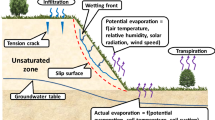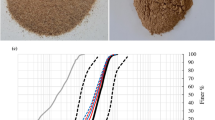Abstract
The shear behavior of soils is typically related to the state of the soil in terms of the initial global void ratio and effective confining stress. However, laboratory tests on reconstituted sand specimens have shown that the shear behavior is also dependent upon the specimen preparation method. This paper describes the findings of a series of studies, which quantitatively evaluated the differences in the inherent microstructure of dilatant sand specimens prepared by air pluviation, moist tamping and water deposition. Quantitative measures such as local void ratio distribution, local void ratio distribution entropy and particle orientation entropy were found to be dependent on the preparation method. Microstructure evolution in the sand specimens during triaxial compression testing was also investigated. Measuring global properties of the specimens was shown to mask the complex and evolving internal conditions during shear. The global response was found to be strongly dependent on the shear induced microstructure which in turn was directly influenced by the preparation method dependent inherent microstructure.
Similar content being viewed by others
References
Bhatia, S. K. and Soliman, A. (1990). “Frequency distribution of void ratio of granular materials determined by an image analyzer.” Soils and Foundations, JSSMFE, Vol. 30, No. 1, pp. 1–16, DOI: https://doi.org/10.3208/sandf1972.30.1
Bourdeau, P. L. (1999). Personal communication, Lyles School of Civil Engineering, Purdue University, IN, USA.
Castro, G. (1969). Liquefaction of Sands, PhD dissertation, Harvard University, Cambridge, MA.
Castro, G., Enos, J. L., France, J. W., and Poulos, S. J. (1982). Liquefaction induced by cyclic loading, Report to National Science Foundation, Washington, D.C., USA.
Chen, C.-C. (2000). Shear induced evolution of structure in water-deposited sand specimens, PhD dissertation, Georgia Institute of Technology, Atlanta, GA, USA.
DeGregorio, V. B. (1990). “Loading systems, sample preparation, and liquefaction.” Journal of Geotechnical Engineering, ASCE, Vol. 116, No. 5, pp. 805–821, DOI: https://doi.org/10.1061/(ASCE)0733-9410(1990)116:5(805)
Emery, J. J., Finn, W. D. Liam, and Lee, K. W. (1973). Evaluation of relative density and its role in geotechnical projects involving cohesionless soils, STP 523, ASTM International, West Conshohocken, PA, USA, pp. 182–194.
Frost, J. D. and Jang, D. J. (2000). “Evolution of sand microstructure during shear.” Journal of Geotechnical and Geoenvironmental Engineering, ASCE, Vol. 126, No. 2, pp. 116–130, DOI: https://doi.org/10.1061/(ASCE)1090-0241(2000)126:2(116).
Frost, J. D. and Kuo, C. Y. (1996). “Automated determination of the distribution of local void ratio from digital images.” Geotechnical Testing Journal, GTJODJ, Vol. 19, No. 2, pp. 107–117, DOI:https://doi.org/10.1520/GTJ10334J.
Frost, J. D. and Park, J. Y. (2003). “A critical assessment of the moist tamping technique.” Geotechnical Testing Journal, Vol. 26, No. 1, pp. 57–70, DOI: https://doi.org/10.1520/GTJ11108J.
Gilbert, P. A. (1984). Investigation of density variation in triaxial test specimens of cohesionless soil subjected to cyclic and monotonic loading, Technical Report GL-84-10, U.S. Army Engineer Waterways Experiment Station, Vicksburg, MS, USA, p. 100.
Gilbert, P. A. and Marcuson III, W. F. (1988). “Density variation in specimens subjected to cyclic and monotonic loading.” Journal of Geotechnical Engineering, ASCE, Vol. 114, No. 1, pp. 1–20, DOI: https://doi.org/10.1061/(ASCE)0733-9410(1988)114:1(1).
Hight, D. W., Gens, A., and Symes, M. J. (1983). “The development of a new hollow cylinder apparatus for investigating the effects of principal stress rotation in soils.” Geotechnique, 33, No. 4, pp. 355–383.
Jang, D.-J. (1997). Quantification of sand structure and its evolution during shearing using image analysis, PhD dissertation, Georgia Institute of Technology, Atlanta, GA, USA.
Jang, D. J. and Frost, J. D. (1998). “Sand structure differences resulting from specimen preparation procedures.” Proc. ASCE Specialty Conference on Geotechnical Earthquake Engineering and Soil Dynamics III, Seattle, WA, USA, Vol. 1, pp. 234–245.
Jang, D. J., Frost, J. D., and Park, J. Y. (1999). “Preparation of epoxy impregnated sand coupons for image analysis.” Geotechnical Testing Journal, GTJODJ, Vol. 22, No. 2, pp. 147–158, DOI: https://doi.org/10.1520/GTJ11274J.
Kuo, C. Y. (1994). Quantifying the fabric of granular materials — Image analysis approach, PhD Dissertation, Georgia Institute of Technology, Atlanta, GA, USA.
Kuo, C. Y., Frost, J. D., and Chameau, J. L. (1998). “Image analysis determination of stereology based fabric tensors.” Geotechnique, Vol. 48, No. 4, pp. 515–525, DOI: https://doi.org/10.1680/geot.1998.48.4.515.
Ladd, R. S. (1974). “Specimen preparation and liquefaction of sands.” Journal of Geotechnical and Geoenvironmental Engineering, ASCE, Vol. 100, No. 10, pp. 118–1184.
Ladd, R. S. (1978). “Preparing test specimens using undercompaction.” Geotechnical Testing Journal, GTJODJ, Vol. 1, No. 1, pp. 16–23, DOI: https://doi.org/10.1520/GTJ10364J.
Mahmood, A. and Mitchell, J. K. (1974). “Fabric-property relationships in fine granular materials.” Clays and Clay Minerals, Vol. 22, No. 516, pp. 397–408.
Mahmood, A., Mitchell, J. K., and Lindblom, U. (1976). Effect of sample preparation method on grain arrangement and compressibility in sand, STP 599, ASTM International, West Conshohocken, PA, USA, pp. 169–192.
Mitchell, J. K., Chatoian, J. M., and Carpenter, G. C. (1976). The influences of sand fabric on liquefaction behavior, Report No. TE 76-1, U.S. Army Engineer Waterways Experiment Station, Vicksburg, MS, USA.
Mulilis, J. P., Chan, C. K., and Seed, H. B. (1975). The effects of method of sample preparation on the cyclic stress strain behavior of sands, EERC Report 75-18, Energy and Environmental Research Center, Grand Forks, ND, USA.
Mulilis, J. P., Seed, H. B., Chan, C. K., Mitchell, J. K., and Arulanandan, K., (1977) “Effect of sample preparation on sand liquefaction.” Journal of the Geotechnical Engineering Division, Vol. 103, No. GT2, pp. 91–108.
Oda, M. (1972a). “Initial fabrics and their relations to mechanical properties of granular material.” Soils and Foundations, JSSMFE, Vol. 12, No. 1, pp. 17–36, DOI: https://doi.org/10.3208/sandf1960.12.17.
Oda, M. (1972b). “The mechanism of fabric changes during compressional deformation of sand.” Soils and Foundations, JSSMFE, Vol. 12, No. 2, pp. 1–18, DOI: https://doi.org/10.3208/sandf1972.12.1.
Oda, M. (1972c). “Deformation mechanism of sand in triaxial compression tests.” Soils and Foundations, JSSMFE, Vol. 12, No. 4, pp. 45–63, DOI: https://doi.org/10.3208/sandf1972.12.4_45.
Oda, M. (1976). “Fabrics and their effects on the deformation behaviors of sand.” Special Issue, Saitama University, Saitama Japan.
Oda, M., Koishikawa, I., and Higuehi, T. (1978). “Experimental study of anisotropic shear strength of sand by plane strain test.” Soils and Foundations, JSSMFE, Vol. 18, No. 1, pp. 25–38, DOI: https://doi.org/10.3208/sandf1972.18.25.
Park, J. Y. (1999). A critical assessment of moist tamping and its effect on the initial and evolving structure of dilatant triaxial specimens, PhD Dissertation, Georgia Institute of Technology, Atlanta, GA, USA.
Rad, N. S. and Clough, G. W. (1984). “New procedure for saturating sand specimens.” Journal of Geotechnical Engineering, Vol. 110, No. 9, pp. 1205–1218, DOI: https://doi.org/10.1061/(ASCE)0733-9410(1984)110:9 (1205).
Rad, N. S. and Tumay, M. T. (1987). “Factors affecting sand specimen preparation by raining.” Geotechnical Testing Journal, GTJODJ, Vol. 10, No. 1, pp. 31–37, DOI: https://doi.org/10.1520/GTJ10136J.
Shannon, C. E. (1948). “A mathematical theory of communication.” Bell Sys. Tech Journal, Vol. 27, DOI: https://doi.org/10.1002/j.1538-7305.1948.tb01338.x.
Shi, B., Murakami, Y., and Wu, Z. (1998). “Orientation of aggregates of fine-grained soil: Quantification and application.” Engineering Geology, Vol. 50, pp. 59–70, DOI: https://doi.org/10.1016/S0013-7952(97)00082-3.
Vaid, Y. P. and Negussey, D. (1988). “Preparation of reconstituted sand specimens.” Advanced Triaxial Testing of Soil and Rock, ASTM STP 977, pp. 405–417, DOI: https://doi.org/10.1520/STP29090S.
Vaid, Y. P., Sayao, A., Hou, E., and Negussey, D. (1990). “Generalized stress-path-dependent soil behavior with a new hollow cylinder torsional apparatus.” Canadian Geotechnical Journal, Vol. 27, pp. 601–616, DOI: https://doi.org/10.1139/t90-075.
Vaid, Y. P., Sivathayalan, S., and Stedman, D. (1999). “Influence of specimen-reconstituting method on the undrained response of sand.” Geotechnical Testing Journal, GTJODJ, Vol. 22, No. 3, pp. 187–195, DOI: https://doi.org/10.1520/GTJ11110J.
Vaid, Y. P. and Thomas, J. (1995). “Liquefaction and postliquefaction behavior of sand.” Journal of Geotechnical Engineering, ASCE, Vol. 121, No. 2, pp. 163–173, DOI: https://doi.org/10.1061/(ASCE)0733-9410(1995)121:2(163).
Wan, R. G. and Guo, P. J. (2001). “Effect of microstructure on undrained behaviour of sands.” Canadian Geotechnical Journal, Vol. 38, No. 1, pp. 16–28, DOI: https://doi.org/10.1139/t00-088.
Windisch, S. J. and Soulie, M. (1970). “Technique for study of granular materials.” Journal of the Soil Mechanics and Foundations Division, ASCE, Vol. 96, SM4, pp. 1113–1126.
Acknowledgements
The research described in this paper was supported in part by the U.S. National Science Foundation contract CMS-9457549. Additional support was provided for researchers in the NSF funded ERC on Bio-mediated and Bio-inspired Geotechnics (CBBG). The support of NSF through PTE Federal Award No. EEC-1449501 is acknowledged. Discussions on the merits of entropy that the senior author had with P.L. Bourdeau were most valuable.
Author information
Authors and Affiliations
Corresponding author
Rights and permissions
About this article
Cite this article
Frost, J.D., Roy, N., Chen, CC. et al. Quantitative Analysis of Microstructure Properties and their Influence on Macroscale Response. KSCE J Civ Eng 23, 3777–3792 (2019). https://doi.org/10.1007/s12205-019-0713-y
Received:
Revised:
Accepted:
Published:
Issue Date:
DOI: https://doi.org/10.1007/s12205-019-0713-y




